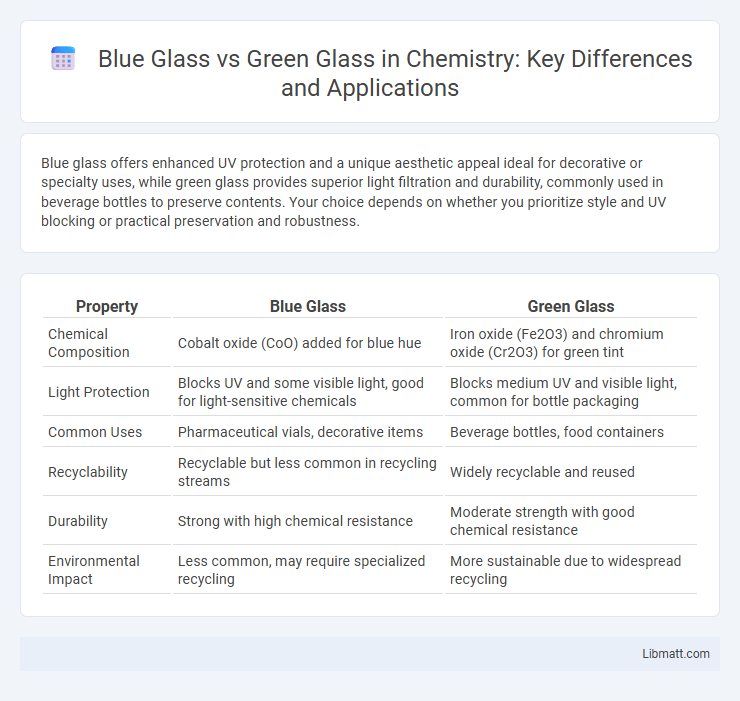Blue glass offers enhanced UV protection and a unique aesthetic appeal ideal for decorative or specialty uses, while green glass provides superior light filtration and durability, commonly used in beverage bottles to preserve contents. Your choice depends on whether you prioritize style and UV blocking or practical preservation and robustness.
Table of Comparison
| Property | Blue Glass | Green Glass |
|---|---|---|
| Chemical Composition | Cobalt oxide (CoO) added for blue hue | Iron oxide (Fe2O3) and chromium oxide (Cr2O3) for green tint |
| Light Protection | Blocks UV and some visible light, good for light-sensitive chemicals | Blocks medium UV and visible light, common for bottle packaging |
| Common Uses | Pharmaceutical vials, decorative items | Beverage bottles, food containers |
| Recyclability | Recyclable but less common in recycling streams | Widely recyclable and reused |
| Durability | Strong with high chemical resistance | Moderate strength with good chemical resistance |
| Environmental Impact | Less common, may require specialized recycling | More sustainable due to widespread recycling |
Introduction to Blue Glass vs Green Glass
Blue glass offers unique aesthetic appeal and enhanced UV protection compared to green glass, which is traditionally favored for its ability to filter sunlight and reduce glare. Green glass typically contains iron oxide, providing natural tinting that helps conserve energy by limiting heat transmission in architectural and automotive applications. Both types serve functional and decorative purposes, with blue glass often used in artistic installations while green glass remains dominant in commercial and environmental sustainability projects.
Color Origins: How Blue and Green Glass are Made
Blue glass is primarily created by adding cobalt oxide or copper compounds to the molten glass, producing its distinct azure hue, while green glass obtains its color from iron oxide and chromium additives. The precise chemical composition and melting temperatures influence the intensity and shade of the colors in both blue and green glass formulations. Incorporating different metallic oxides during the manufacturing process determines the final appearance and transparency levels in colored glass products.
Key Differences in Composition
Blue glass contains cobalt oxide as its primary coloring agent, whereas green glass typically incorporates iron oxide or chromium oxide for its hue. The distinct chemical compositions affect not only the color but also the glass's light absorption and UV protection properties. Your choice between blue and green glass can influence aesthetic appeal and functional benefits depending on the intended use.
Visual Appeal: Aesthetic Comparisons
Blue glass offers a striking, cool-toned aesthetic that evokes tranquility and sophistication, making it ideal for modern or coastal-themed decor. Green glass provides a natural, earthy vibe often associated with vintage or rustic styles, enhancing spaces with a warm, organic touch. Your choice between blue and green glass will shape the ambiance by influencing color harmony and visual interest in any setting.
Functional Uses and Applications
Blue glass is commonly used in pharmaceutical and cosmetic packaging due to its ability to filter out harmful UV light, protecting light-sensitive products and preserving their quality. Green glass is often utilized in the beverage industry, particularly for wine and beer bottles, as it provides moderate UV protection and is visually associated with freshness and sustainability. Both blue and green glass are favored for decorative purposes in lighting and architectural elements due to their appealing colors and durability.
Light Transmission and UV Protection
Blue glass typically allows moderate light transmission while offering enhanced UV protection by filtering out a higher percentage of harmful ultraviolet rays. Green glass provides a balanced light transmission with natural glare reduction and moderate UV blocking capabilities, making it suitable for various lighting conditions. Both types of glass are engineered to optimize visibility and protect interiors from UV damage, but blue glass is often preferred in applications requiring superior UV filtering.
Environmental Impact and Recycling
Blue glass and green glass differ in their environmental impact primarily due to variations in raw materials and recycling processes. Green glass typically contains iron, chromium, and copper, which give it color and allow for efficient recycling with lower energy consumption, resulting in fewer carbon emissions. By choosing blue glass, Your recycling options might be slightly more limited, as some facilities prioritize green glass because it can be recycled more easily and reused in a wider range of products, supporting better sustainability.
Popularity in Art and Architecture
Blue glass has gained significant popularity in art and architecture for its striking, calming aesthetic and ability to enhance natural light in spaces, often featured in stained glass windows and decorative accents. Green glass, favored for its earthy and organic appeal, is commonly used in sustainable building designs and eco-friendly art installations due to its association with nature and environmental consciousness. Both glass types contribute unique visual and symbolic qualities that influence artistic expression and architectural styles worldwide.
Cost and Availability
Blue glass tends to be more expensive and less readily available compared to green glass due to its lower production volume and the rarer materials required for its distinctive color. Green glass is commonly produced and widely distributed, leading to reduced costs and easier access for various applications. You can expect to find green glass at a more affordable price and with greater availability across packaging, decorative, and industrial uses.
Choosing Between Blue and Green Glass
Choosing between blue and green glass depends on your aesthetic preference and the desired ambiance for your space. Blue glass provides a calming, cool tone ideal for modern or coastal designs, while green glass offers a natural, earthy feel suited for rustic or eco-friendly decor. Consider your lighting conditions and complementing colors to ensure your choice enhances your room's overall atmosphere.
blue glass vs green glass Infographic

 libmatt.com
libmatt.com